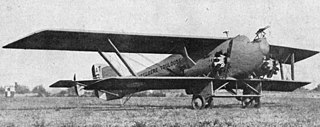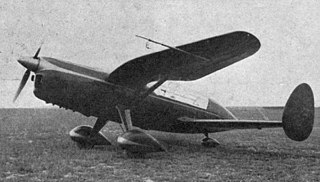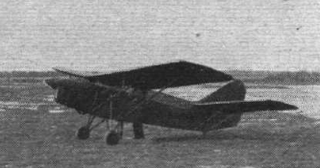Related Research Articles

The Latécoère 6 was a French four-engined biplane bomber of the early 1920s. It was of advanced all-metal construction and probably the first aircraft to use geodetic construction. Only one was built.
The Latécoère 340 was a three-engined, parasol winged flying boat designed in 1929 in France for middle-distance, overseas routes. The sole prototype was destroyed early in the testing programme, and no more were built.
The Latécoère 550 was a four-engined French seaplane, designed in the early 1930s as a bomber/torpedo bomber. Though initial handling problems were partly resolved, the aircraft was deemed too slow and did not go into production.
The Farman F.480 Alizé was a single engine, two seat, parasol winged monoplane built in France in the mid-1930s. Designed as a tourer and trainer, all Alizés served as training aircraft for government (Republican) forces during the Spanish Civil War.

The Farman FF 65 Sport was a French built light biplane, with a single engine and tandem seats, intended for sport and touring. First flown in 1919, it achieved modest sales at home and abroad in the early 1920s. Two unusual modifications produced a biplane glider and a low aspect ratio parasol wing machine.
The Starck AS-37 is a two-seat biplane with unconventional wing and propulsion layouts. It was designed in France in the 1970s; though three were built and more than twenty sets of plans sold for home building, no AS-37s are active in 2012.
The Briffaud GB-10 Pou-Push was a Mignet style tandem wing single seat aircraft with a pusher configuration single engine. The sole example was built in France in the 1980s.

The Albatros L.71 was a two-seat, single pusher engined biplane built in Germany in the 1920s.
The Landray GL.01 is a small tandem-wing, side-by-side seat sport aircraft of the Mignet Pou-du-Ciel type. Built in the mid 1970s, the single example remains active.
The Langlois JL.2 was a three-winged agricultural aircraft built in France in 1979. It failed to sell and only one was built.
The Landray GL.02 Ami Pou was a very basic, low-powered French tandem wing, single-seat sports aircraft. The only example flew in 1979.
The Piel CP-10 was a post-war French sports aircraft in the Pou du Ciel tradition and was the first design from Claude Piel to fly.

The Caudron C.140 was a French tandem cockpit sesquiplane designed in 1928 as a combination of liaison aircraft and observer and gunnery trainer.

The Caudron C.74 was a ten-seat, four engine passenger biplane built in France in 1922. It showed promise but the sole prototype crashed fatally in a competition and no more were completed.

The Albessard Triavion, sometimes known as the Peyret-Albessard Triavion, was a three surface aircraft, combining a tandem wing and conventional tailplane.

The Delanne 20-T was a French tandem wing aircraft designed as an aerodynamic model for a larger fighter aircraft. It was tested during 1939.

The SFCA Taupin was a French tandem-wing aircraft, designed to provide a simple, stable and safe aircraft able to take-off and land in small spaces.
The Lacroix-Trussant L.T.-51 Microplan was a French, low-powered, two seat amateur-built biplane. It flew just before the outbreak of World War II. After the war it was re-engined and flew until 1953.
The Avia 60-MP was a French motor glider with a wing based on that of the Avia 32-E, an advanced training glider. It was intended as both an advanced trainer and as an atmospheric research aircraft.
The Morane-Saulnier MS.152 was a French multi-purpose aircraft built in 1928. It did not go into production.
References
- 1 2 3 4 Taylor, John W. R. (1981). Jane's All the World's Aircraft 1981-1982. London: Jane's Information Group. p. 487. ISBN 0710607059.
- 1 2 3 Etienne-Claude Landray. "Les Avions de Gilbert Landray - GL 1" . Retrieved 27 November 2014.
- 1 2 3 4 5 6 7 8 9 10 Gaillard, Pierre (1991). Les Avions Francais de 1965 à 1990. Paris: Éditions EPA. p. 179. ISBN 2-85120-392-4.
- ↑ Chillon, Jacques. Fox Papa - Registre des avions Français amateur (2009 ed.). Brive: Ver Luisant. p. 168. ISBN 978-2-3555-1-066-3.
- ↑ Partington, Dave (2010). European registers handbook 2014. Air Britain (Historians) Ltd. ISBN 978-0-85130-465-6.